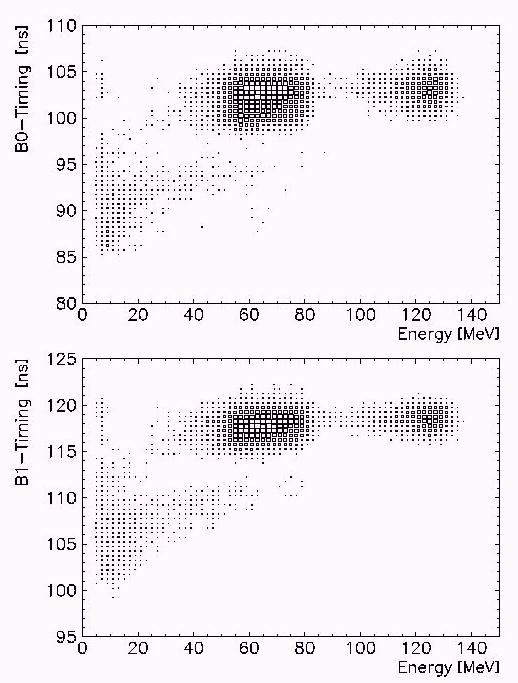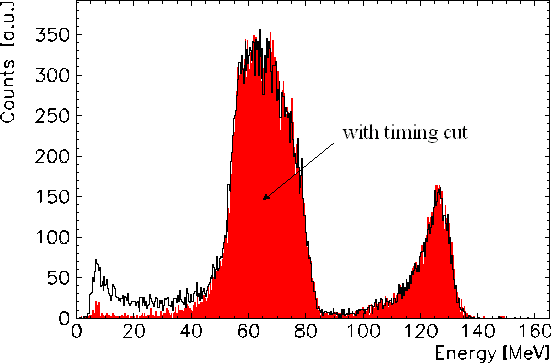





7.5.2 Neutron Cut
The trigger gates could not be made with sufficiently small width to exclude
all neutrons from RC to enter the detector accidentally with the opened
calorimeter gate. Timing was determined by a hit of the CsI array exceeding 2
MeV of deposited energy. The flight distance and the timing resolution are
sufficient to discriminate neutrons and photons. The time of flight (TOF) of
the photons between the LH2 target and the CsI array amounts to 2.9 ns, while
8.9 MeV neutrons pass the 86 cm within 21.0 ns. Plotting the deposited energy
in the calorimeter against the timing of B0- or B1-counter one observes the
neutrons coming before the photons. As can be seen in Figure 7-13 the TDC
spectrum of the B1-counter, for instance, clearly distinguishes photon and
neutron response, together with beam related background.
 Figure 7-13. The timing of the B0 and B1 counters, triggered by a hit in the
CsI calorimeter, is plotted against the energy deposition in the Calorimeter.
Due to the time of flight difference most of the neutron background (see text
for details).
In order to gain dynamic range the sum of the TDC values of B0 and B1 was used
to cut out the neutron background (225.3 ns > T(B0)+T(B1) > 214.9 ns).
This procedure additionally yielded a proper timing of the photons relative to
the beam particles; the timing difference of the TDC peaks of B0 and B1 was
(15.5±1) ns. 82% of the data passed this cut. As a result remaining
neutrons[35] are well separated from the
photons and do not contribute to the systematical error.
Figure 7-13. The timing of the B0 and B1 counters, triggered by a hit in the
CsI calorimeter, is plotted against the energy deposition in the Calorimeter.
Due to the time of flight difference most of the neutron background (see text
for details).
In order to gain dynamic range the sum of the TDC values of B0 and B1 was used
to cut out the neutron background (225.3 ns > T(B0)+T(B1) > 214.9 ns).
This procedure additionally yielded a proper timing of the photons relative to
the beam particles; the timing difference of the TDC peaks of B0 and B1 was
(15.5±1) ns. 82% of the data passed this cut. As a result remaining
neutrons[35] are well separated from the
photons and do not contribute to the systematical error.

Figure 7-14 Demonstration of the effect of the timing cut. The low energy
background disappears besides some well-separated neutrons.
The background in the energy range of the photons can be identified as coming
from scattered beam pions (below 40 MeV) and - as shown in sect. 6.4 -
bremsstrahlung photons, also in-flight SCX and RC on top of a neutron pulse
would be possible. The ambiguity of the interpretation of the background below
the SCX distribution contributes to the systematical error with 0.2%.
[35] Some neutrons from a previous beam bucket
happen to have nearly the timing - (21-19.75) ns - of the photons.




















